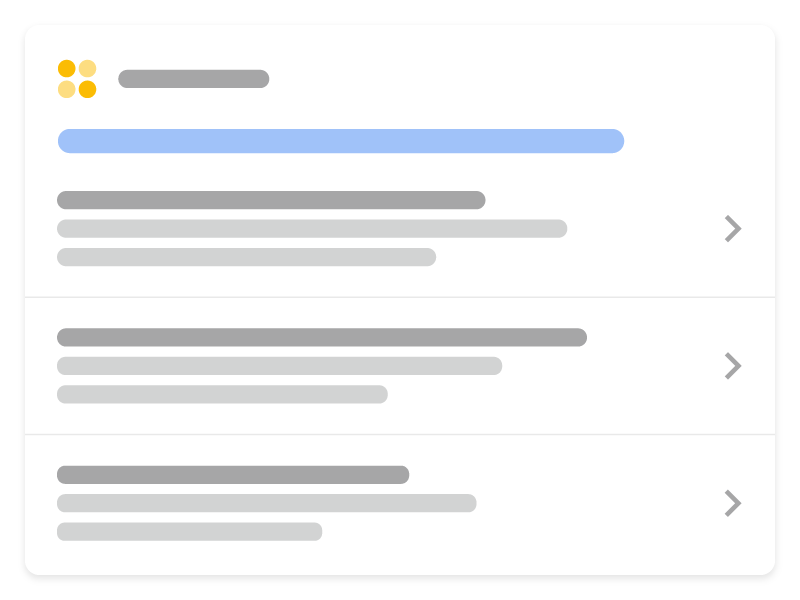課程清單 (Course) 結構化資料

有了課程清單結構化資料,您就可以提供課程的更多資訊,讓有興趣的學生透過 Google 搜尋找到您的課程。您可以提供課程的名稱、提供者和簡短說明等詳細資訊。
功能適用情況
凡是提供 Google 搜尋服務的所有地區,都能以英文顯示課程清單複合式搜尋結果。
如何新增結構化資料
結構化資料是一種標準化格式,能夠提供網頁相關資訊並分類網頁內容。如果您是第一次使用結構化資料,請參閱這篇文章,進一步瞭解結構化資料的運作方式。
以下簡要說明如何建立、測試及發布結構化資料。
- 新增必要屬性。根據您使用的格式,瞭解要在網頁中的什麼位置插入結構化資料。
- 遵循指南規範。
- 使用複合式搜尋結果測試驗證程式碼,並修正所有重大錯誤。此外,我們也建議您修正工具中可能標記的任何非重大問題,因為這有助於改善結構化資料的品質 (但並非符合複合式搜尋結果的顯示條件)。
- 部署幾個包含結構化資料的網頁,並使用網址檢查工具測試 Google 轉譯網頁的情形。請確認 Google 可以存取您的網頁,且網頁並未遭到 robots.txt 檔案或
noindex標記封鎖,也未設有登入規定。如果網頁看起來沒問題,您可以要求 Google 重新檢索您的網址。 - 為了讓 Google 掌握日後的異動內容,建議您提交 Sitemap。您可以使用 Search Console Sitemap API 自動執行這項操作。
範例
單一課程詳細資料頁面
以下是單一課程詳細資料頁面的範例。這個網頁必須與含有 ItemList 標記的摘要頁面配對。
<html>
<head>
<title>Introduction to Computer Science and Programming</title>
<script type="application/ld+json">
{
"@context": "https://schema.org",
"@type": "Course",
"name": "Introduction to Computer Science and Programming",
"description": "Introductory CS course laying out the basics.",
"provider": {
"@type": "Organization",
"name": "University of Technology - Eureka",
"sameAs": "https://www.example.com"
}
}
</script>
</head>
<body>
</body>
</html>全包式單一網頁
以下是全包式單一網頁的範例: 這個網頁設定包含清單標記,以及同一網頁中各項課程的詳細資料。
<html>
<head>
<title>Computer Science Courses</title>
<script type="application/ld+json">
{
"@context": "https://schema.org",
"@type": "ItemList",
"itemListElement": [
{
"@type": "ListItem",
"position": 1,
"item": {
"@type": "Course",
"url":"https://www.example.com/courses#intro-to-cs",
"name": "Introduction to Computer Science and Programming",
"description": "This is an introductory CS course laying out the basics.",
"provider": {
"@type": "Organization",
"name": "University of Technology - Example",
"sameAs": "https://www.example.com"
}
}
},
{
"@type": "ListItem",
"position": 2,
"item": {
"@type": "Course",
"url":"https://www.example.com/courses#intermediate-cs",
"name": "Intermediate Computer Science and Programming",
"description": "This is a CS course that builds on the basics learned in the Introduction course.",
"provider": {
"@type": "Organization",
"name": "University of Technology - Example",
"sameAs": "https://www.example.com"
}
}
},
{
"@type": "ListItem",
"position": 3,
"item": {
"@type": "Course",
"url":"https://www.example.com/courses#advanced-cs",
"name": "Advanced Computer Science and Programming",
"description": "This CS course covers advanced programming principles.",
"provider": {
"@type": "Organization",
"name": "University of Technology - Eureka",
"sameAs": "https://www.example.com"
}
}
}
]
}
</script>
</head>
<body>
</body>
</html>指南規範
您必須遵守以下規範,課程清單才會顯示您的課程資訊。
內容指南
Course標記只能用於符合以下課程定義的教育性質內容:以演講、授課或專題的方式,探討特定主題和/或題目的一系列課程或一門課程。- 課程必須對特定主題/題目的知識/技能有明確教育意義,並且由一或多位講師向參與課程的特定一群學生授課。
- 「天文日」之類的一般公開活動不算是課程,一部 2 分鐘的「三明治製作教學影片」也不算。
技術指南
您必須標記至少三門課程。這些課程可以分別放在獨立的詳細資料頁面,也可以放在同一個全包式網頁中。
每個課程都必須具備有效的 name 和 provider 屬性。以下舉例說明無效的命名方式:
- 宣傳短語:「世界上最棒的學校」
- 課程標題含有價格:「學習烏克麗麗只要 $30 美元!」
- 使用非課程內容做為標題,例如:「參加這門課程就能快速賺取收入!」
- 提供折扣或購買機會,例如:「各領域的專家分享獨門祕訣;可享 75 折優惠!」
結構化資料類型定義
您的內容必須包含必要的屬性,才能以複合式搜尋結果的形式呈現。 您也可以加入建議的屬性,為內容增添更多相關資訊,提供更優質的使用者體驗。
Course
請使用下列屬性來標記至少三門課程。這些課程可以分別放在獨立的詳細資料頁面,也可以放在同一個全包式網頁中。
schema.org/Course 內提供 Course 的完整定義。Google 支援的屬性如下:
| 必要屬性 | |
|---|---|
description |
課程說明,顯示長度上限為 60 個字元。 |
name |
課程的標題。 |
| 建議屬性 | |
|---|---|
provider |
發布課程來源內容的機構。例如:加州大學柏克萊分校。 |
ItemList
除了 Course 屬性之外,請再新增下列屬性來指定清單。您可以將這些屬性新增至摘要頁面或全包式網頁。
schema.org/ItemList 內提供 ItemList 的完整定義。
| 必要屬性 | |
|---|---|
itemListElement |
單一項目頁面的註解。 |
ListItem.position |
項目頁面在清單中的序數位置。 |
ListItem.url |
項目頁面的標準網址。每個項目都必須有一個專屬網址。 |
疑難排解
如果無法順利導入結構化資料,或是偵錯時遇到困難,請參考下列資源。
- 如果您使用內容管理系統 (CMS) 或者有他人代您處理網站事務,請向對方尋求協助。請務必將所有與問題相關的 Search Console 訊息都轉寄給對方,這些訊息會針對問題提供詳細說明。
- Google 不保證採用結構化資料的功能一定會顯示在搜尋結果中。如要瞭解為何 Google 無法將您的內容顯示為複合式搜尋結果,請參閱結構化資料通用指南裡的常見原因清單。
- 結構化資料可能含有錯誤。請查看結構化資料錯誤清單和無法剖析的結構化資料報告。
- 如果您的網頁遭到結構化資料人工判決處罰,系統會忽略網頁上的結構化資料,但該網頁仍然會出現在 Google 搜尋結果中。請使用人工判決處罰報告來修正結構化資料問題。
- 再次查看指南規範,確認您的內容是否符合規定。問題可能是因為垃圾內容或不當使用的標記所引起。不過,因為問題可能與語法無關,所以複合式搜尋結果測試無法找出問題所在。
- 參閱「疑難排解:未出現複合式搜尋結果/複合式搜尋結果總數減少」。
- 請等待一段時間,讓系統執行重新檢索和重新建立索引作業。在發布網頁後,Google 可能需要幾天時間才會找到網頁並進行檢索。如有關於檢索和索引建立作業的一般問題,請參閱 Google 搜尋檢索和索引常見問題。
- 前往 Google 搜尋中心論壇發文提問。
